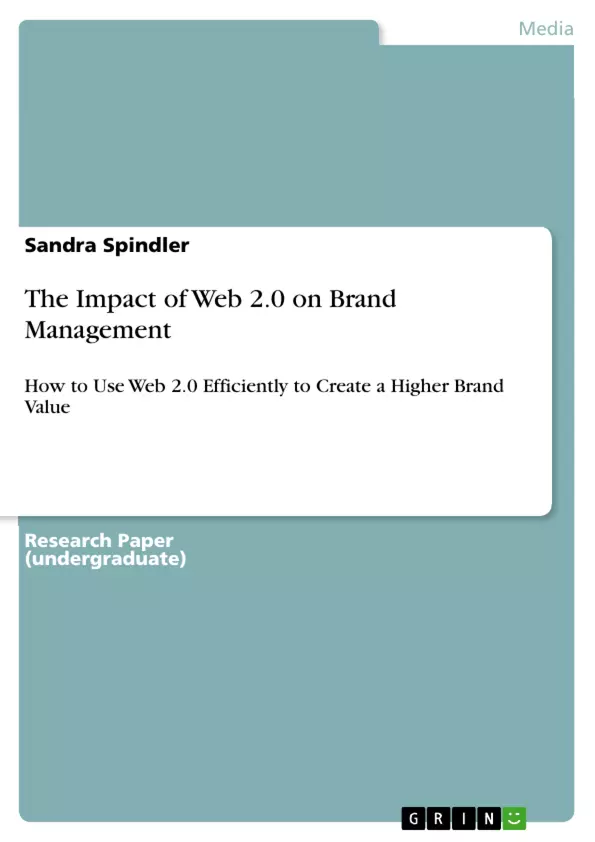This report “The Impact of Web 2.0 on Brand Management– How to Use Web 2.0 Efficiently to Create a Higher Brand Value-” has been written within the minor International Business Management (MLA7 individual topic) at the economical university of applied science FIHE in Venlo. This module offers students the opportunity to realise theoretic knowledge. Furthermore the student can choose a topic according to his interest and it also serves for preparation of the bachelor thesis. A time limit of three months was given for processing this report and also a limit of 20 pages.
This report will demonstrate the importance of involving Web 2.0 in marketing-strategies. Examples of companies which suffered from Web 2.0 as they did not know how to react properly will be pointed out. Furthermore the change from one-way communication to two-way communication will be described and following possible measurements and strategies will be recommended to increase a company’s brand value.
The Impact of Web 2.0 serves as a guide for companies who are not well versed in this topic but intend to increase their brand value by means of social media marketing measurements. Nevertheless basic knowledge about marketing and e-marketing terms is required. However some terms are listed in the glossary but will not explained within the text as this would go beyond the scope of this report.
Inhaltsverzeichnis (Table of Contents)
- Title Page
- Summary
- Preface
- Table of Contents
- Glossary
- 1 Introduction
- 2 Theoretical Foundations
- 2.1 Brand Definition
- 2.2 Functions of a Brand
- 2.3 Definition of Brand Management
- 2.4 Definition of Web 2.0
- 3 The use of Web 2.0
- 3.1 Private Use
- 3.2 Web 2.0 in Business
- 4 Web 2.0 - Friend or Foe?
- 5 From One-Way to Two-Way Communication
- 6 Web 2.0 and Brand Management
- 6.1 The Impact of the Change of the Communication Models on Website Content
- 6.2 How to Respond to Unjustified Negative Word of Mouth
- 6.3 Integrating Users into Marketing Processes
- 6.4 The “Open” Brand
- 7 Conclusion
- 8 Recommendation and Critical Appraisal
- Bibliography
- List of Figures
- List of Tables
- List of Abbreviations
- Appendix: The Frequency of Web 2.0 Visits
Zielsetzung und Themenschwerpunkte (Objectives and Key Themes)
The paper aims to explore the potential of Web 2.0 as a marketing instrument by analyzing its usage and awareness. It will outline strategies for increasing brand value, supported by real-world examples of successful implementation. The report emphasizes the importance of adapting marketing strategies to Web 2.0 and recognizing its impact on communication models.
- The impact of Web 2.0 on brand management and marketing strategies.
- The shift from one-way to two-way communication in the digital era.
- Strategies for leveraging Web 2.0 to enhance brand value and customer engagement.
- The importance of managing online reputation and responding to negative feedback.
- The role of user participation and collaboration in shaping brands and marketing campaigns.
Zusammenfassung der Kapitel (Chapter Summaries)
The report begins by introducing the concept of Web 2.0 and its significance in modern marketing. It then delves into the theoretical foundations of brand management, defining key terms and concepts. The paper explores the use of Web 2.0 both in personal and business contexts, highlighting the increasing importance of social media platforms. The report further examines the shift from one-way to two-way communication in the digital landscape and analyzes the impact of this change on brand management. Finally, it presents strategies for integrating Web 2.0 into marketing plans, emphasizing the importance of building relationships with consumers, managing online reputation, and leveraging user participation.
Schlüsselwörter (Keywords)
The main keywords and focus topics of the text are Web 2.0, brand management, social media marketing, customer engagement, online reputation, two-way communication, brand value, marketing strategies, and user participation. The report explores the influence of Web 2.0 on these key areas and presents practical strategies for businesses to effectively utilize its potential.
- Quote paper
- Sandra Spindler (Author), 2011, The Impact of Web 2.0 on Brand Management, Munich, GRIN Verlag, https://www.grin.com/document/197615



